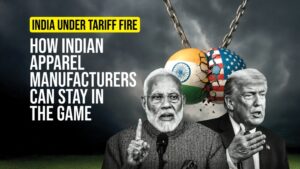
During India’s struggle against the world’s second-largest Covid-19 outbreak, the garment industry encountered unparalleled obstacles. Fashion, amongst the hardest-hit segments, witnessed many manufacturers succumb to the economic downturn. However, amidst the chaos, Sudhir Dhingra, Owner of Orient Craft Ltd., an over four-decade-old garment house based in Gurugram – stood resilient.
Sudhir embarked on his journey in 1972 with a mere Rs. 15,000 in his pocket. By February 2020, he had ascended to the pinnacle of his business, achieving an annual revenue of Rs. 2,200 crore. His operations boasted the production of 150,000 to 200,000 pieces daily across 26 facilities, powered by a robust workforce of 32,000 individuals.
The pandemic and conflicts with other Orient Craft promoters led to a downturn, bringing the business perilously near to closure, impacting the lives of thousands of associates and suppliers.
Today, as the dust begins to settle and the clouds of uncertainty part, Sudhir Dhingra stands tall as a testament to the power of perseverance and resilience. He has settled all his dues with every stakeholder. His remarkable journey from adversity to triumph serves as an inspiration to all, a beacon of hope in the face of adversity and a reminder that with unwavering determination, anything is possible.
In an exclusive interview with Apparel Resources, Sudhir shares insights from his nearly five decades in the garment industry, lessons learned, his future plans and his perspectives on advancing the industry. Here are the edited excerpts.
AR: What were the contributing factors to your setback?
Sudhir Dhingra: Though there were few hiccups and setbacks due to some trivial disputes amongst promoters, I am glad to state that all promoter disputes are settled now. Over the past four years, I’ve dedicated myself to resolving these issues, as we’ve worked hard to build valuable assets and maintain a healthy financial position.
We have successfully cleared all dues with the banks, including the payment of Rs. 1080 crore to banks and an additional Rs. 325 crore to employees and creditors. The banking community has been fully reimbursed, including all interest and penalties, without any settlements. We willingly and happily chose to pay the entire amount without any deductions to achieve the status of a star promoter, earning love and respect from all stakeholders. Currently, we are in the process of reimbursing every former employee who has left our organisation, as well as every supplier.
Today, we are completely debt-free. In fact, a senior representative from the State Bank of India visited us to personally deliver a ‘No Due Certificate’. The representative conveyed his astonishment, expressing that in his 27-year tenure in the recovery department, he had never come across a promoter or company voluntarily settling their dues to this extent.
We have managed to clear our debts by selling properties that weren’t even mortgaged. In one instance, we sold a property for nearly Rs. 600 crore, demonstrating our determination to fulfil our financial obligations and maintain our financial integrity. Ultimately, our reputation means everything to me.
While we did incur a mere loss of Rs. 17 crore during lockdown, it’s important to note that for a company with an annual turnover of Rs. 2000 crore and an EBITDA ranging from Rs. 150 to Rs. 300 crore over the past many years, this loss didn’t significantly impact our overall performance.
A similar challenge arose during the 2008 financial crisis when my CFO persuaded me to sign papers for Foreign Exchange Derivatives. With the collapse of Lehman Brothers, our business faced turmoil, resulting in a sudden loss of Rs. 300 crore. Despite others urging to shut down the company and flee, I remained steadfast in my resolve to find a solution.
We owed Rs. 165 crore to Barclays Bank and I negotiated for a 60-month repayment plan. Over the next five years, we diligently paid US $ 565,000 monthly, clearing every penny owed. Together, we collaborated to expand our business from Rs. 600 crore to Rs. 1400 crore. It’s worth highlighting that challenges also present opportunities for growth.
AR: Navigating through such hardships likely takes a toll on one’s mental and emotional well-being.
Sudhir Dhingra: Yes, it did! I was led to believe that my company had nothing left. The realisation that nearly 50 years of hard work had seemingly vanished without my knowledge was deeply unsettling. During a period in 2020, I endured five long months without a minute of sleep. At my lowest point, a family member suggested that I recite Hanuman Chalisa daily. Taking his advice, I began reciting and in just 10 days, I felt rejuvenated and reinvigorated, as if I had regained my former strength and determination. Pehle main Sher tha, ab main Babbar Sher hoon (Earlier I was a tiger, now I am a lion). I am ready to face challenges head-on.
| During a period in 2020, I endured five long months without a minute of sleep. At my lowest point, a family member suggested that I recite Hanuman Chalisa daily. Taking his advice, I began reciting and in just 10 days, I felt rejuvenated and reinvigorated, as if I had regained my former strength and determination. Pehle main Sher tha, ab main Babbar Sher hoon (Earlier I was a tiger, now I am a lion).Sudhir Dhingra, Owner of Orient Craft Ltd. |
AR: What valuable insights did you gain from overcoming this challenge?
Sudhir Dhingra: Life is a journey of learning and I also have my fair share of experiences. It’s crucial never to rely solely on one customer or product. That’s why I instilled in my teams the principle that no single customer should account for more than 15 per cent of our total turnover. I imposed a limit on our exposure. During our heyday, we never engaged in business exceeding Rs. 350-400 crore with any single customer. This approach taught us the importance of diversifying our customer base and not fixating on one country, especially since we solely focus on exports. Also, customer delight should always be top priority.
The culture we’ve nurtured is something I hold dear and it’s a message worth sharing with the industry. Instead of fostering a cutthroat environment, prioritise building a culture where people aren’t just compelled to work, but genuinely enjoy being part of something greater.

For instance, once someone joins our team, they become part of our family and remarkably, very few ever choose to leave. Out of our workforce of 32,000, approximately 10,000 have devoted 10 to 15 to 20 years of service. Remarkably, these are the people who have been with us for 40-45 years and to this day, I maintain personal connections with them. I have shared my personal contact number with each and every one in my company.
We’ve established a culture where taking care of our people is paramount. For instance, I negotiated a comprehensive deal with an insurance provider to ensure that every member of our team and their families are covered, even those with pre-existing conditions. Many of our associates have elderly parents and various health concerns and it’s crucial that they feel supported and protected.
Now, let me share my weakness with you. I’ve never considered myself a financial expert—I didn’t receive formal education in finance nor did I attend a business school. However, when venturing into business, understanding risk management is paramount. Additionally, having a solid grasp of finance and accounting is essential for any entrepreneur.
I made the mistake in assigning financial matters to my relatives when they should have been managed by professionals, under the supervision of auditors.
AR: What strategies did you employ to effect a turnaround?
Sudhir Dhingra: In our journey, one of my key initiatives was to shift away from the traditional garment centres such as Gurgaon, Chennai and Noida. These areas are facing significant challenges, including high labour costs exceeding an average of Rs. 20,000 and various compliance issues. Even if you’re committed to paying double overtime and providing benefits, the financial constraints within this industry make it difficult to sustain. With customers demanding lower prices, it only adds to the frustration amongst the workforce. Seeing no viable future in these areas, I intentionally redirected our focus and established a large-scale facility in Ranchi in Jharkhand.
We’ve been operating in our new factory for nearly a year-and-a-half now. I’ve transitioned my entire production to this facility which I believe to be the largest in the country in one location.
This facility boasts 2500 machines working double shift equating to 5000 machines under one roof, enabling us to manufacture a diverse range of products, including intimate apparel, knitted sportswear, women’s and men’s garments, garment dyeing, embroidery (both machine and hand), sweaters and more.
Currently, our monthly output stands at around Rs. 10-12 crore, with the plant having the capacity to produce up to Rs. 100 crore worth of goods each month. Currently, we are working with 4 to 5 of our previous customers. With the resolution of old Orient Craft issues, I am now dedicated to expanding this business and reconnecting with other customers.
AR: How feasible and advantageous is it to transition from traditional hubs to emerging hotspots like Ranchi, Jharkhand?
Sudhir Dhingra: In the garment industry, the majority of labourers hail from states like Uttar Pradesh, Bihar, Jharkhand and Odisha, so it makes sense to venture into these regions. However, transitioning to a new location is not a bed of roses, especially when it comes to labour training. Training the locals and embracing new cultural norms are essential steps involved in the process. There is no shortage of workforce, but they need to be trained. You will get only 10 per cent trained workforce. As per the Ministry of Labour and Employment, over 8,24,000 individuals moved from Jharkhand to other states due to employment related reasons.
Fortunately, my background in running training centres across India over the past 18 years under India’s skill development program provided a valuable resource. With 18 centres established nationwide, including four in Jharkhand, three in Odisha and several in Uttar Pradesh, we had a pool of trained labourers to draw from. Many of these skilled workers returned to us, streamlining the training process for both managers and staff.
Also, attempting to use the same management style as in Delhi-NCR, including abrasive language, will not work in these regions, instead, it will lead to workers refusing to return to work, necessitating manufacturers to revaluate their approach. Moreover, workers in these regions are typically reluctant to work overtime, resulting in decreased productivity levels in the short term. Achieving optimal efficiency could take around three years under favourable conditions, and in more challenging situations, it might extend to six-seven years.
In 2017, I set up a small factory in Ranchi, but later decided to consolidate my manufacturing operations there at one larger facility. I closed down other factories across the country. At that time, suitable garmenting infrastructure was scarce, but now there has been significant improvement.
The Plug and Play model, as seen in Bihar, offers a promising solution. Several states such as Bihar, Odisha and Uttar Pradesh are embracing similar approaches, indicating numerous opportunities beyond just Jharkhand.
This recommendation was initiated by me to the Jharkhand government and is currently in progress, while some states have swiftly implemented it, drawing inspiration from Jharkhand’s initiative.
AR: As someone who has drafted the Jharkhand textile policy, you have a valuable first-hand experience in shaping industry regulations. Can you share your insights and experiences from
this process?
Sudhir Dhingra: Absolutely! It was a stroke of luck, really. The former Chief Minister of Jharkhand, Raghubar Das Ji, had a deep empathy for workers, stemming from his own experience as a labourer in the coal mines. One day, by chance, he visited one of our training centres upon the recommendation of the local district collector. Impressed by the quick training turnaround and job placements for trainees within 60 days, he expressed a keen interest in meeting me.
In 2016, I had the opportunity to meet Raghubar Das Ji in Delhi. While appreciating our work and the culture, he encouraged me to establish a factory in Jharkhand. He highlighted the limited employment opportunities for women in the state, often leading to serious issues like human trafficking. Many girls are forced into roles as domestic workers or even resort to prostitution. However, I expressed my reservations, explaining that our existing manufacturing units in other regions were not operating at full capacity, making the prospect of opening a new unit seem impractical.
Raghubar Das Ji, undeterred, offered incentives such as cheap electricity and land. However, I emphasised that reducing the cost of operation was crucial for the garment industry, rather than focusing solely on land and electricity. During our conversation, he inquired about the total cost of creating employment for 100,000 individuals, to which I estimated government support of around Rs. 200-300 crore. The figure surprised him; he had anticipated it to be significantly higher. It was then that he offered me the opportunity to draft the new textile policy for the state.
Despite my reluctance to draft the policy myself, citing potential conflict of interest, the CM insisted that I draft the Jharkhand Textile, Apparel and Footwear Policy 2016. Some of the key points I proposed included measures for affordable land, employment subsidies and enhanced support for women and tribal communities. Additionally, I recommended providing 20 per cent subsidy for building construction and machinery procurement.
For example, the state government committed, through a policy decision, to provide an employment generation subsidy of Rs. 5,000 for every employed person for seven years, plus Rs. 1,000 for ESI/PF. In case of women and scheduled castes, it was Rs. 6,000 + Rs. 1,000.
Moreover, amended labour laws have eliminated ‘inspector raj’, allowing for single joint inspection and a single annual return for 14 labour laws under the Self-Certification Scheme. Additionally, the state has implemented a single window system with a single login and time-bound approvals. Incentives on various fronts related to setting up a business are also available, including a 7 per cent interest subsidy and 20 per cent capital subsidy capped at Rs. 50 crore. One of the most attractive incentives is 50 per cent reimbursement on power tariffs for seven years from the date of electricity connection release, along with 100 per cent electricity duty exemption for seven years. This translates to around Rs. 2.5 per unit to ensure uninterrupted power supply, compared to the typical Rs. 12-14 per unit in Delhi-NCR, with a 60 per cent consistent grid supply balance through private power generation.
AR: What is your future roadmap?
Sudhir Dhingra: I don’t mean to sound boastful or arrogant, but in the next five years, my goal is to achieve what took me 50 years to accomplish. I am determined to reach and cross the peak I attained in March 2020.
I am currently in the process of building a strong team. I have already trained enough individuals so that this company will be running on autopilot for the next 24 months.
I’m not rushing to bring in new clients quickly; instead, I’m focusing on gradual growth. By focusing on nurturing relationships with our existing four key customers, I anticipate generating over Rs. 300 crore in revenue in the next 12 months, aiming for Rs. 500 crore in the subsequent year and Rs. 700 crore in the third year.
Currently, our business is 100 per cent export-oriented, but we aim to shift 30 per cent towards domestic operations within the next three years. Regarding product diversification, we believe
we already cater to all consumer segments effectively.






